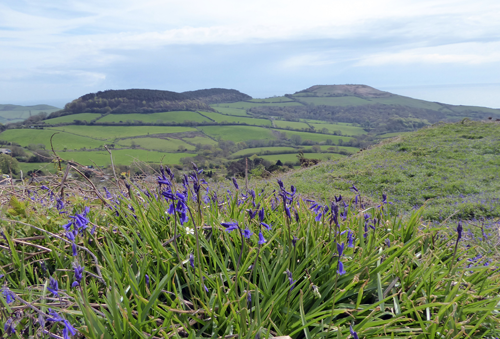It was a luminous spring morning in early May when I trekked up Hardown Hill in west Dorset. Hardown rises steeply above Morcombelake and the surrounding countryside affording fine views of the coast and of the Marshwood Vale. Compared with its well-known cousin, Golden Cap, across the valley, this flat-topped hill is unjustly ignored but its heathland summit boasts a rich ecology supporting several rare species and, for many years, Hardown Hill was a busy semi-industrial site where building stone was mined.
It’s a steep climb to the top of Hardown Hill but finally, the stony track flattens out and I enter a heathland landscape, rare in this part of Dorset. The summit is broad and flat and typical low-growing heathland plants such as gorse and several species of heather flourish here on the acid soil. Pale sandy tracks cut swathes across the heath but, even on a sunny morning in springtime, the feeling is sombre, dominated by dark browns and greens. A few mature birch trees and a small copse of pine trees provide relief and I come across a pond surrounded by tall clumps of pale, dried grass and a struggling sallow. This heath habitat is also the home of rare nightjars, sand lizards and Dartford warblers.
Standing on the Hardown summit is an elemental experience. Today, a moderate wind blows from the west, rising and falling like the sound of surf on the strand. The heath vegetation rustles and fidgets in response, accompanied by skylarks trilling high overhead. I watch a spirited storm tracking across Lyme Bay and prepare to shelter but, in the end, it mostly avoids the land leaving the sun to return. All of this is overlaid on the southern side by the ebb and flow of traffic noise from the busy A35 some distance below.
The heath may look uninviting and barren, but this is springtime and there are many signs of renewal. A few clumps of yellow gorse stand out above fresh grey-green growth and heathers push feathery green and red shoots upwards. Submerged in the thick heath vegetation are the small bright blue and white flowers of heath milkwort piercing the darkness like stars in the night sky. In the past, the flowers were thought to resemble small udders and this may account for the plant’s name as well as its administration to nursing mothers by medieval herbalists. Along path edges on the northern side of the heath, I find several generous clumps of a shrub with pale fleshy leaves, green with a tinge of pink. This is bilberry, covered at this time of year with delicate, almost transparent, pale red, lantern-shaped flowers looking out of place in this harsh environment but proving popular with bumblebees and hoverflies. Late summer will see the plants covered with succulent black fruits.
I encounter only one other person on the heath but it hasn’t always been such a quiet place. From medieval times, Hardown Hill would have resounded to the clash of picks and shovels wielded by men mining the landscape for building materials. Beneath the thin layer of soil that covers the summit, there are layers of clay and a yellow/brown sandy material containing substantial lumps of flint-like, hard rock, the chert cobs. A mixture of clay, stone and sand was taken for road construction and the chert cobs were used for building. Mining occurred on the southern slopes of the Hill, either in open pits or in adits (mine shafts) cut into the hillside. Nowadays there are few traces of this busy activity. The mining area has mostly been colonised by rough grass and bracken, brightened today by a haze of bluebells. One open pit has been preserved near the top of Love’s Lane displaying the layers of rock and the chert cobs. The adits are inaccessible for safety reasons but one serves an important role as a hibernation area for the rare lesser horseshoe bat.
The chert cobs were split using a small hammer on a long handle, the Hardown hammer. Cobs were held on an iron bar with three claws and covered in damp hessian to protect the eyes of workmen who also wore wire goggles. Split cobs were used to provide a tough outer surface, silvery-blue or yellowish, on domestic and farm buildings around the Marshwood Vale. Good examples of the use of Hardown chert can also be found on the 14th century abandoned chapel at Stanton St Gabriel beneath Golden Cap and on the tiny 19th century church at Catherston Leweston.
But it is to the height of Hardown Hill that I want to return. Its prominence above the surrounding countryside gives spectacular views with new perspectives on some of west Dorset’s notable landmarks. Looking southwards, we see Golden Cap and the darkly-wooded Langdon Hill rising steeply across the valley with a backdrop of the waters of Lyme Bay. Towards the east, Portland floats unsettlingly as if cast adrift. To the north, especially from Hardown’s rough grassy flanks, we look across the patchwork of fields and the ring of hills that make up the Marshwood Vale with the village of Whitchurch Canonicorum cradled in its green embrace. New perspectives challenge us to think differently and the relative isolation of Hardown fosters quiet contemplation away from the cares of everyday life.
Perhaps that’s what Thomas Hardy meant when he wrote in his poem Wessex Heights:
“There are some heights in Wessex, shaped as if by a kindly hand
For thinking, dreaming, dying on, …”
Philip Strange is Emeritus Professor of Pharmacology at the University of Reading. He writes about science and about nature with a particular focus on how science fits into society. His work may be read at http://philipstrange.wordpress.com/








